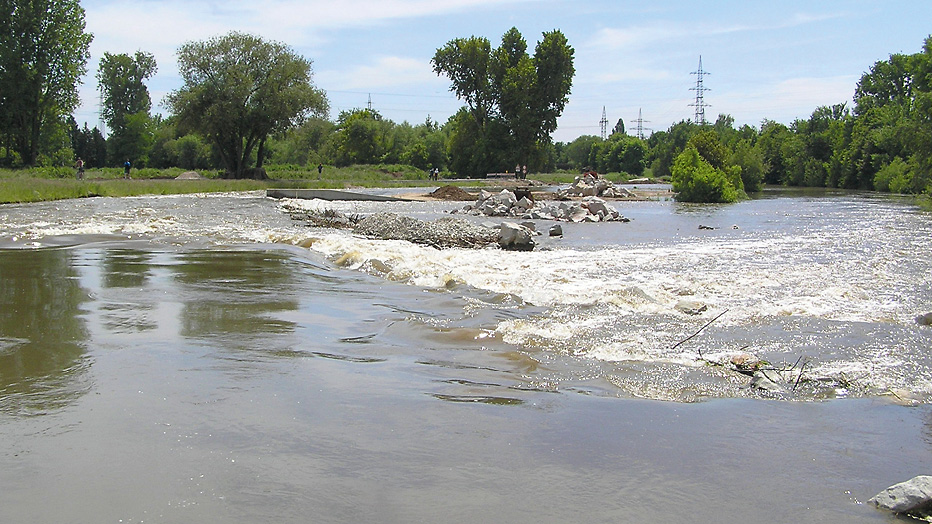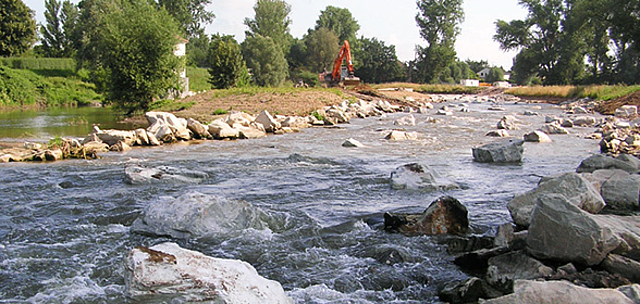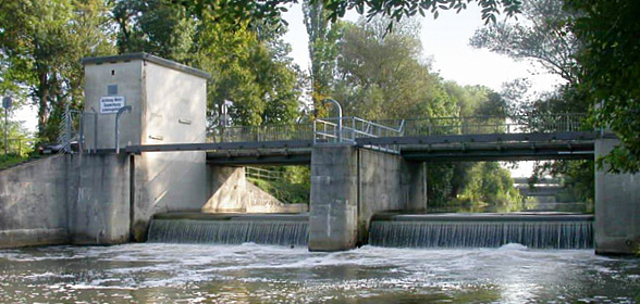Project Profile
Project Title: „Near-natural restructuring of the Nidda“
Subject Cluster: Climate Protection and Open Spaces
Project Objectives: Clarifying structural improvements on the Nidda: natural water structuring, removal of migration obstacles for fish and other water organisms, more attractive riverside paths, maintaining flood protection facilities and ground water level.
Project Participants: Stadtentwässerung Frankfurt
Contact: Roland Kammerer Heiko Kramer Stefanie Toth, Stadtentwässerung Frankfurt am Main
Re-naturalising the banks of the Nidda and rebuilding the weirs create new habitats for flora and fauna, upgrade the recreation area for the inhabitants and guarantee protection against flooding.
In the 20th century, the Nidda in the North of Frankfurt, once abundant in fish, was channelled, dammed and straightened. River bends were cut off, filled or converted into backwaters while new weirs prohibited fish migration. All this may have offered excellent flood protection but it turned the river into a canal.
In the 1990s, the communities along the Nidda developed a re-naturalisation programme for the river, the “Natural Nidda“ concept. It was agreed on by the Frankfurt City Council in 1998.
The conversion started between Berkersheim and Bonames. One backwater was re-connected. Floodplains, flatter riverbanks, a more natural river profile and sand- and gravel banks now offer flora and fauna new habitats.
A “Weir Study” in the 1990s showed that re-building the weirs on the Nidda was possible without jeopardising flood protection or significantly altering the groundwater table. The weirs in the Frankfurt area were included in Hessen’s catalogue of measures in order to implement the targets of the European Water Framework Directive.
Höchst Weir: fish ladder and flood protection
In 2012/2013, the weir in Höchst was replaced by a side weir, placed transversely in the river, which guides some of the water into a new channel beside the weir and serves as a gently sloping fish ladder. The old flood protection dam was removed and re-built around a silted-up backwater. During flooding on the Nidda or when the Main overflows into the Nidda, the additional retention area is under water. The riverside path was set on the new dam and the old weir bridge replaced.
The fish are coming back
Today, shortly after the conversion, the numbers of current-loving fish species, such as the Common Barbel, the Common Nase and the Common Dace have already increased. Sea trout migrate from the Main into the Nidda and its side waters. The bypass and the gravel banks below the weir are the riffle minnow’s nursery – a species thought to have become almost extinct in Hessen.
Rödelheim Weir: the mill race as a bypass
Although a large-scale conversion of the weir was not possible since it borders on houses and Brentanopark, the old mill race could, however, be re-built as a ramp so fish can swim through.
Sossenheim Weir: involving the residents in the planning process
The current status of the planning for the weir in Sossenheim is that the old weir will be replaced by a side weir to channel the river water into the Grill’schen backwater, which in turn will be connected to the Nidda, making the river passable for fish and other aquatic species. The riverside path will be remodelled and new bridges cross the inlet and outlet of the meander.Well before the planning approval procedure, a planning workshop gave residents the opportunity to learn more about the plan.
They discussed ideas and suggestions with the planners which would be included, wherever possible, in the planning, whereby flood protection and a stable groundwater table were to be guaranteed. Application for approval was filed with the Regional Council in Darmstadt in 2016.
Upgrading the river banks as a recreation area
The re-naturalisation process also made the banks of the Nidda riverside more attractive to the public. The riverside path, which is extremely popular among walkers and cyclists, no longer follows the monotonous, dead-straight Nidda, but leads along richly diverse riverbanks with trees, shrubs, meanders and meadows opening onto splendid views over the river.

Living space
Re-connected meanders, floodplains, sand and gravel banks and gentler slopes offer new habitats for flora and fauna; re-building the weirs and ramps as fish ladders.

Recreation area
Providing more diversified banks with trees, shrubs, meanders and meadows give more attractive natural experiences; newly-designed, curved riverside paths and new bridges.

Flood protection
Creating additional retention areas; guaranteeing flood protection and stable groundwater table when converting the weirs.
Waste Water Department
Roland Kammerer
Tel +49 (0)69 212-33188
roland.kammerer(at)stadt-frankfurt.de
Heiko Kramer
Tel +49 (0)69 212-32897
heiko.kramer(at)stadt-frankfurt.de
Stefanie Toth
Tel +49 (0)69 212-35778
stefanie.toth.eb68(at)stadt-frankfurt.de




